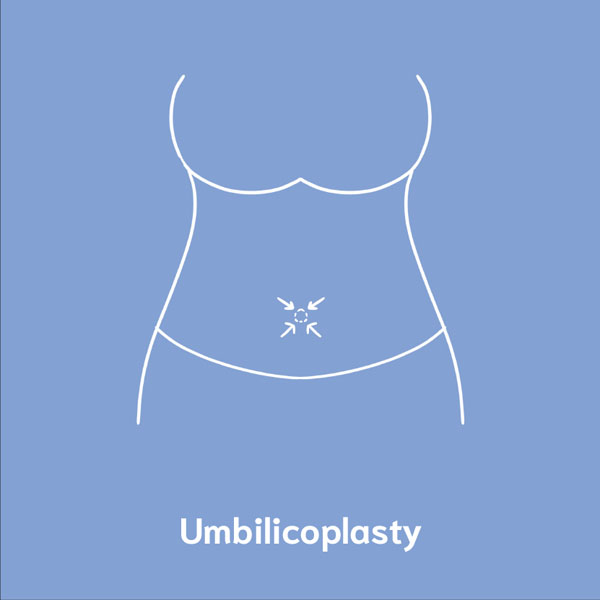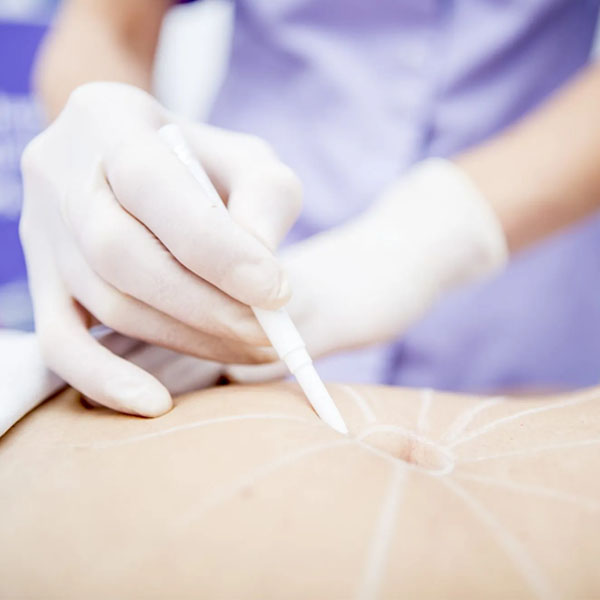Belly Button

Umbilicoplasty plays a crucial role in abdominoplasty procedures, as the umbilicus is often considered the central focal point of the abdomen's aesthetics. In this explanation, we will outline our favored technique for umbilicoplasty, which involves utilizing a half-moon design and conducting periumbilical defatting. Our experience with this approach consistently yields aesthetically satisfying outcomes.
What is Belly Button Surgery?

Umbilicoplasty, a procedure aimed at altering the appearance of the bellybutton, has an interesting history. Initially utilized to address umbilical hernias in infants, it has evolved over the years into a sought-after cosmetic surgery.
The primary objective of umbilicoplasty remains consistent: to transform the bellybutton from a horizontal shape to a more vertical one. This change is particularly sought after by women post-pregnancy or individuals with scarring resulting from a previous bellybutton piercing. Embraced by those desiring to enhance their bellybutton's aesthetic, umbilicoplasty has become a popular choice in the realm of cosmetic enhancements.
How is Belly Button Surgery done?

During the umbilicoplasty procedure, skilled surgeons like Dr. Harish employ a technique that aims to minimize scarring by making incisions inside the belly button. This approach allows for the removal of excess fat, tissue, and skin, enabling the area to be artfully reshaped and restructured according to the patient's and doctor's pre-discussed preferences established during the initial consultation. If there is a small hernia or bulging tissue, it can also be addressed simultaneously. In certain cases, an umbilical hernia might be present and can be rectified during the procedure as well.
Once the desired shape is achieved as agreed upon during the consultation, the incisions are carefully closed. The typical outcome of the umbilicoplasty procedure is a belly button that appears neatly "tucked in," displaying a vertical oval shape with a subtle hooding effect over the top region, contributing to an aesthetically pleasing result.
Risks associated with Belly Button Surgery
All surgeries, even small cosmetic procedures, carry some risks. Anaesthesia, though generally safe, can slightly increase the risk of blood clots or pneumonia, especially if you have underlying medical conditions like diabetes or high blood pressure.
- Post-umbilicoplasty, potential complications include infection or bleeding in the belly button area.
- Scarring is a typical outcome of umbilicoplasty, which is important to consider, particularly when the procedure is performed to address a piercing scar.
Promptly contact your doctor if you experience any of the following symptoms in the weeks after the surgery:
- Severe bleeding
- Nausea
- Dizziness
- Pain that doesn't go away
- Signs of infection, such as a fever, unusual smell, or colored discharge.
Why should you choose Umbilicoplasty?
If the sight of your belly button makes you uncomfortable wearing a bikini or looking at yourself in the mirror, taking steps to repair it through umbilicoplasty can significantly boost your self-esteem and elevate your overall quality of life.
- Repairing piercing scars.
- Restoring stretched navels resulting from pregnancy.
- Correcting misshapen navels caused by fluctuations in weight.
- Treating hernias.
- Rectifying protruding belly buttons.
Through the expertise of our surgeons in Livglam Clinic and the umbilicoplasty procedure, you can achieve a more aesthetically pleasing and confident belly button appearance, allowing you to embrace a new level of self-assurance and satisfaction in your daily life.
What is the cost of Belly Button Surgery?
In India, the expenses associated with Belly Button Surgery typically vary between ₹70,000 and ₹80,000, with the highest end of the cost spectrum reaching around ₹90,000. These figures encompass the various factors involved in the surgical procedure, ensuring that patients have a range of options available to meet their specific needs and budget constraints.
Frequently Asked Questions:
The ideal candidate for umbilicoplasty is dissatisfied with the appearance of their belly button and seeks to improve its aesthetics. It is commonly considered by individuals with stretched or misshapen navels due to pregnancy, those with unsightly piercing scars, or individuals with hernias or protruding belly buttons. However, eligibility for the procedure will be determined during a consultation with the surgeon.
Umbilicoplasty is typically performed under anesthesia, so patients do not feel pain during the surgery itself. However, some discomfort and soreness may be experienced during the initial days of recovery. The surgeon will provide pain management options to ensure a more comfortable healing process.
The duration of umbilicoplasty can vary depending on the complexity of the case and the extent of corrections required. On average, the surgery may take one to two hours. It is important to discuss the estimated duration with the surgeon during the initial consultation.
Yes, the results of umbilicoplasty are generally considered permanent. The surgical procedure aims to reshape the belly button, and the outcome should last for many years. However, it is essential to maintain a healthy lifestyle and manage weight fluctuations to preserve the aesthetic results over time.
The immediate results of umbilicoplasty will be noticeable after the surgical site heals. However, it may take a few weeks for the initial swelling to subside and the outcome to become fully apparent. Patients should follow the post-operative care instructions provided by the surgeon to optimize the healing process and achieve the best results.
Procedure Time:
- 2-5 hours
Full Recovery:
- 6 weeks
Anaesthetic:
• General
Back to work:
• After 2 weeks
Duration of results:
• Permanent
Results:
• Noticeable within 2 weeks
Temporary risks & complications:
• May include soreness, bleeding, persistent pain, and infection
• *Individual results and reactions may vary.
